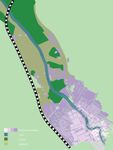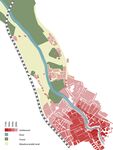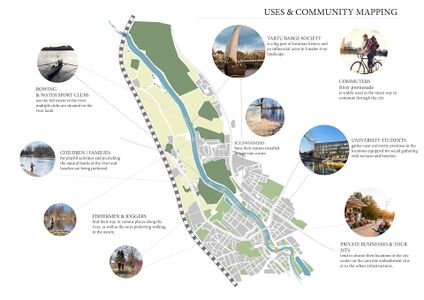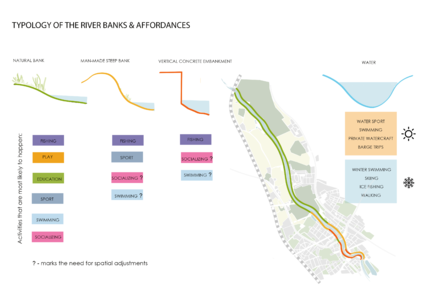Tartu WAVE Living Lab Team 1 2022
>>>back to working groups overview
| Area | Tartu Emajõgi Upper part I | |
| Place | Tartu | |
| Country | Estonia | |
| Topics | Accessibility, biodiversity | |
| Author(s) | ||

| ||
Rationale
- Why do you think this case is relevant? What is your hypothesis considering the landscape challenges?
- Format: 3-4 sentences
Location and scope
You can edit this map with the map editor
Water as a natural system
Geomorphology, typologies and dynamics of water areas
Emajõgi (Suur-Emajõgi), the largest rivers in Estonia; length 101 km, river basin with Lake Võrtsjärv basin 9960 km2 (of which 98 km2 in Latvia), average flow 71.8 m3 / s. The width of the river is 20–145 m, the maximum depth is 11 m (up to 18 m at the mouth), the total slope is 3.5 m, the average flow speed is 3.7 km / h. It starts from Rannu-Jõesuu in the northeast corner of Lake Võrtsjärv and flows to Lake Peipus in Prague.
From Võrtsjärv to the Kärevere bridge (40 km), the river meanders and is rich in swamps (old rivers). In the upper and lower reaches, the river flows in marshy shallows, in the middle reaches the ancient valley (the width of the valley above Tartu is 1 km, elsewhere even more, the depth is up to 20 m). In the upper and lower reaches there are swamps and meadows (floodplains), which are under water during high water. Floods also occur in Tartu during high water. The water level in the Emajõgi River can fluctuate from 1.2 to 2.6 m per year.
It is 57 km from Lake Võrtsjärv to Tartu and 43 km from Tartu to Lake Peipus. Back in 1927, the length of the Emajõgi River was 117 km, but later the river has been dredged and channeled. The special feature of the Emajõgi River is its abundance of water bodies, 102 in total. Most of the old rivers are a 35 km long section from the mouth of the Pedja (Pede) river to the village of Kärevere.
During high water (usually in May, but sometimes also in winter), when the flow of the Pede (Pedja) River is so large that it does not flow in the direction of Lake Peipsi, the Emajõgi changes direction in the six-kilometer section between the Pede estuary and Lake Võrtsjärv. The upstream part of the Emajõgi River is several times wider than usual at that time and is also called the Järvejõgi River. The reverse flow is slow, 7 cm / s.
It is 57 km from Tartu to the source of the Emajõgi River in Võrtsjärv and 43 km to the mouth of Lake Peipsi. The river is navigable in its full length. In the past, shipping and fishing played an important role. Until 1775. Until the fire, the Emajõgi River flowed in two branches above the city, forming a small island above the current nightclub "Atlantis" (see also Koolujõgi). The springs flowing out of the tributaries of the primeval valley created smaller tributaries that disappeared from today's cityscape. The bed of one of these was located above the present department store. The Burgundian knight Ghillebert de Lannoy is in his travelogues in the 15th century. said: "Tartu is a very beautiful and well - fortified city and there is a fortress by three rivers ...".
The higher water level of the river was registered in Tartu in 1867. in May 373 cm above the zero of the graph. In the 1920s, the banks of the Emajõgi River were fortified and raised, and boulevards and green areas were built there. 1947-2002 the lowest water level was 30.09.1996, 29.30 m above zero.
- Yourcase watersystem1.jpg
add a caption
- Yourcase watersystem2.jpg
add a caption
- Yourcase watersystem3.jpg
add a caption
Water as a living space
Man and Emajõgi. Fishing.
36 fish species have been caught in the Emajõgi, 10 of which are erroneous. The most caught fish are pike, bream, perch, roach and roach. Eels, carp, tench, pikeperch, linseed, ling and peat are also caught. It is also quite common to catch a breeder whose fishing is currently prohibited by fishing rules.
Interest in various fish species has changed throughout history: in pre-war Estonia, pike were caught on the Emajõgi River during the German occupation, roaches during the Soviet occupation, as well as perch (as it began to be dried) and perch. Until the Second World War, fish were caught on the Emajõgi River mainly with nets, and after the war, trapping and net fishing were also used. In 1958–1976, a fisherman's collective farm called Lenin operated on the Emajõgi River, in 1976 the fisherman's collective farm Peipsi Kalur was established. Today, there are some self-employed fishermen who use the edge traps of the Emajõgi River for fishing. A very popular recreational fishing spot. From 2009 to 2010, the South Estonian Fishermen's Club estimated the number of fishermen on the Emajõgi River from March to October: based on this estimate, the fishing effort is approximately 100,000 fishing days per year.
Emajõgi Festival, an annual celebration taking place in Tartu since 2006, focusing on the Emajõgi River. It is usually held on the weekend of August 2nd. There will be boat parades, swimming and fishing competitions, concerts on the river bank and on ships, etc., various water attractions, water-related institutions and companies will be introduced. Boat trips on the Emajõgi River will be organized for those interested. The best known of the sports competitions are the Emajõgi Cup in open water swimming and the "Sprint of Two Bridges" from Kaarsilla to Võidu Bridge. The fishing competition is called "River of Good Techniques".
- Your case green blue infrastructure1.jpg
add a caption
- Your case green blue infrastructure2.jpg
add a caption
Blue and Green Infrastructure
The only connection to the city's green network is the green corridor running along the Emajõgi River (the side on its left bank and in the area of Tartu municipality). The most ecologically valuable green areas are in the Emajõgi Green Corridor: Ropka – Ihaste meadow nature reserve with river banks to Luunja municipality, Anne nature reserve and protected areas between the protected areas, Kardla-Vorbus support areas, Kvissental settlement shore areas.
The only blue infrastructure in the area is the Supilinna pond. Areas covered by the green network: Dendropark, Cemetery outcrop, Tallinn University Botanical Garden, Ülejõgi Park, green zones on the Emajõgi bank.
Dendropark
Tähtvere dendropark is an area managed by the Tartu City Economics Department, located behind the buildings of the Estonian University of Life Sciences, between the Tartu Singing Stage and the Emajõgi River, the entrance to which is at the intersection of Tuglas, Tähtvere and Herne streets towards the Emajõgi beach. Dendropark is a versatile leisure place, which was established in the 1970s under the leadership of the Estonian University of Life Sciences by planting diverse and also rare trees. All the trees planted are no longer there, but the list of rarities includes black spruce, American wound, paper oak, red oak, gray walnut, and walnut and American larch.
Cemetery outcrop
Devonian sandstone outcrop on the left bank of the Emajõgi primeval valley in Tartu. The outcrop is located above the cemeteries on Puiestee Street (Uus-Jaani and Vana-Peetri cemeteries). The protected area of the cemetery outcrop was established in 1957 by the decision of the executive committee of the TSN of the city of Tartu.
Tallinn University Botanical Garden
The Botanical Garden is located near the center of Tartu, on the west bank of the river. At present, the water system of the garden is characterized only by a pond, which is a remnant of moats filled with water from previous times. There are no natural plant communities in the botanical garden. The main reasons for this are the small size of the garden and its central location. The botanical garden is home to typical animals and birds adapted to urban conditions.
Ülejõe park
The park is located between Narva Road and Emajõgi on the section between Kaarsilla and Vabadussilla. The park houses the Hugo Treffner Monument and the Friedebert Tuglas Memorial. The park creates a good connection with the green network of the Emajõgi River.
Green zones on the banks of the Emajõgi River
The banks of the Emajõgi River are delimited on both sides by greenery, either by bushes or green areas, which can sometimes be connected to public beaches.
- Your case green blue infrastructure1.jpg
add a caption
- Your case green blue infrastructure2.jpg
add a caption
Water as a cultural space
Land use and water
1732 (estimated year) map
Settlement mostly inside the city wall area and not along river Emajõgi. The river area is not used, the landscape is natural and not managed. Only one bridge to cross the river to get inside the city wall area where the settlement is.
1884/1839 map
Settlement has grown quite a bit in the city center in our area, but also a few houses outside along the river side. Riverside is mostly not managed and has a natural landscape. There are a few access points to the river which could be used for shipping and fishing. The railway was built and opened in 1876.
1923-1935 map
Settlement has not grown significantly but there are more houses near the river outside the city center. The land use along the river is mostly agricultural. New development regarding the land use is to some extent industry. Like for example on both sides of a blacksmith, vodka brewery, tavern on both side of the river and agricultural school nearby. River itself is used also for fishing and for entertainment purposes such as swimming or boating.
1997-2003 map
Settlement has grown vigorously. Due to the II WW the industrial and entertainment use of the river has been lost. The riverside consists mostly of wetlands and green areas. There are not very many access points to the river and it is not used for recreational purposes as it was after the I WW period.
Cultural and spatial typologies of water areas
The spatial patterns of the area which is mostly riverside that has been natural landscape and not managed changed during the beginning of 20th Century when with the city growth the nearby water area was used as well. Fishing and boating for commercial and entertaining purposes were popular. Industry related to the railway and blacksmiths, brewery and taverns all activated the usage and spatial development of the Emajõgi river. This action created the need for some maintenance and access points to the river.
Role of the water area in overall urban morphology is to open the river to people so it can be used as an important and vital part of urban space. Also water as an urban morphology feature is crucial for air quality improvement in urban areas. It is like a blue cleaning channel for the air. If the river is running through the city of Tartu then Emajõgi should absolutely be a connector and not a divider regarding urban morphology.
Sacred spaces and heritage
Emajõgi is a cultural cradle and spine of Estonians, it has enormous cultural and symbolic value as a core text of Estonian identity.
The heritage that is connected to Emajõgi is mostly symbolic as the river itself has acquired a central position in Estonian cultural memory.
Emajõgi is a symbol of education - Tartu is often called Athens of Emajõgi. Here is the place where wisdom flows - sometimes also called Tartu vaim (The spirit of Tartu). National awakening movement in the 19th century started from Tartu, the most famous Estonian female poet Lydia Koidula, who was called Emajõe Ööbik - The Nightingale of the Emajõgi, had strong connections with Tartu. First song festival took place in Tartu and the Estonian national flag was invented in Tartu by students. Emajõgi has a cultural meaning to all 100 000 alumni that have graduated from the university.
Emajõgi is also a cultural divider in the Estonian mental landscape. River acts as a border to frame South-Estonian identity. When you cross Emajõgi another world opens - South-Estonia with different languages (võro, seto, mulgi), worldview and more traditional lifestyle.
- Index.php?title=File:045864 ERM Fk2821 88 pisipilt.jpg
Outdoor swimming area was very popular in 1930s. Photo: Estonian National Museum, ERM Fk 2821:88
- Index.php?title=File:Emajõgi, 1913..jpg
Emajõgi, 1913. River was a vital part of Tartu city. Photo: Tartu University Museums. UAMF 201_17
Visual appearance and landscape narrative
Main narrative in art and literature that is connected with Emajõgi is definitely sense of belonging, a bit of nostalgy and a lot of pseudomythology (birth of Vanemuine and Emajõgi as “paradise of first humans”).
Emajõgi has recently gathered a lot of graffiti artist’s attention to add interpretation to historical art and react to social problems. In the beginning of 20th century Tartu was the center of a famous art school - Pallas Art School - pallaslane is a term that everyone knows in the Estonian art scene.
Water and People
Accessibility and usability
Emajõgi river takes a central part in the Tartu city, dividing the city in two parts serving as an axis of the city's development. The Tartu City municipality is seeing the improvement of the riverfront accessibility and activating the river banks as one of its main objectifs. When addressing the issue of accessibility it is possible to distinguish 5 different aspects:
1) Accessibility TO the riverfront: it varies throughout the city changing as you move from the city center up the river to the city border. In the city center multiple streets are leading to the river but as toward the city borders the density is decreasing, so does the number of exits to the river. In some cases the natural areas, e.g. Supilinna pond and dendropark, serve as a river buffer – where little paths leading to the river are known only to the locals. In other cases recent real estate development as in Supilinn and Kvissental block the access to the longer stretches of the riverside. There are two parking lots on each side of the river catering to the beach areas and maritime recreational center Lodjakoda.
2) Accessibility ALONG the riverside: riverfront in Tartu is reserved for the pedestrians and cyclists (on the Western side of the river). On the Western side of the river the promenade gradually transforms into hiking trail – the main drawback of which is its linear character – after reaching your “turnback” point, which is quite often determined by seasonality, you have to take the same route back. The walkability of the route decreases towards the outskirts of the city presenting both physical – the lack of the route maintenance, flooding etc. – and psychological barriers (signs prohibiting trespasses, fenced areas with the dogs, leaving you only a narrow strip by the river to walk through).
3) Accessibility ACROSS the river: the city center is provided with the 4 bridges located closely to each other facilitating easy movement across the river, whereas in the upstream part of Tartu the lack of bridges lead to the substantial increasement of physical and psychological distances: 2 Emajõe beaches located within 200 m on the opposite banks require a 2,5 km hike to get from one point to another increasing the distance up to 10 times. 4) Accessibility with public transport: the nearest stops to the public beaches lie within 700 m walking distance, which can be quite problematic for elderly or families with little children – the further you go from the center, the more problematic is the access to the riverside by public transport.
5) Water infrastructures – sport, water travel, recreation.
The usability of the riverside is largely defined by the typology of the river banks which falls into three categories:
1) the vertical concrete embankment of Emajõgi in the city center providing no direct access to the water allows only for the passive use of space as an “observer”, there is no much room for interaction and the participant is limited to a role of” the spectator in the theater” – the territory quite effectively, though seasonally, used by business owners – little riverside cafes. Other than that the promenade is used for walking, being the most pleasant way to travel the city in summers. In the recent decade the city started installing different types of terraces along the promenade and the most popular prove to be the ones with the closest access to water.
2) the man-made steep bank covered with natural vegetation constructed to prevent flooding – allows for linear movement, as only single users, mostly fishermen, take the effort to go down the steep bank to reach the water. The territory is popular among joggers, also widely used for walking purposes – the linear types of usage – not encouraging to stop and explore.
3) natural banks allow for the widest variety of use – recreational, play, educational – as well as direct engagement with the water as in swimming and bathing.
Community Mapping
Social groups
Children
Families
Teenagers
Youngster/students
Sport enthusiasts
Seniors
Tourists
Stakeholders
Tartu University
Local communities (eg. Emajõe Lodjaselts, Supilinna selts)
Sport clubs (Paddling , rowing, etc.)
Small businesses (catering and entertainment)
Local residents
External stakeholders
Tartu municipality
Environmental Board
Conservation
Restoration Board
- Your case your community map1.jpg
add a caption
- Your case your community map2.jpg
add a caption
- Your case your community map3.jpg
add a caption
Possible Futures
- You can summarize your findings with a SWOT diagram and a DPSI(R) Model
- Link back to the Sustainable Development Goals: Which goals are at risk?
- What is your worst case scenario for this landscape?
- What is your best case scenario for this landscape?
- Present your scenarios in the form of a collage or sketch
- Add text and visuals
- Your case your spider diagram or dpsir model.jpg
explain your analysis briefly in the caption
- Your case yourworstcase visual.jpg
explain your worst case scenario briefly in the caption
- Your case yourbestcase visual.jpg
explain your best case scenario briefly in the caption
Collaborative Goal Setting
- Define strategic planning objectives based on the evaluation findings from your analysis
- Ideally, involve the community of your living labs into this process
- Link back to your original targets from section one and the Development Goals
- 150 words text contribution
Spatial Strategy and Transect
- translate your strategic goals into a vision
- develop a spatial translation of your vision
- exemplify your vision in the form of a transect with concrete interventions
- add map(s) and visualizations
- Your case spatial translaton vision.jpg
add caption here
- Your case transect.jpg
add caption here
- Your case transect detail1.jpg
add caption here
- Your case transect detail2.jpg
add caption here
From Theory of Change to Implementation
- For implementing your vision: Which partnerships are needed? Which governance model is required?
- Who needs to act and how? Draw and explain a change/process model/timeline
- Which resources are needed? On which assets can you build?
- add 150 words text and visuals
References
- https://info.raad.tartu.ee/muinsus.nsf/0/22868BE1F9CF7CB7C22568CD00252A27
- https://emajogi.metsamang.natmuseum.ut.ee/
- https://emajogi.metsamang.natmuseum.ut.ee/emajoe-valgala-interaktiivne-kaart/
- https://www.tartu.ee/sites/default/files/uploads/Linnaplaneerimine/yldplaneering2030/Lisa_1_Tartu_linna_YP_KSH_aruanne_koos_lisadega_kehtiv.pdf
- https://gis.tartulv.ee/yldplaneering2040/loodus/?page=page_5&views=view_38
- http://eestiloodus.horisont.ee/index.php?id=4785&id_a=4760
- https://dspace.emu.ee/xmlui/handle/10492/1085?locale-attribute=en
- https://teele.luts.ee/taxonomy/term/154
- https://et.wikipedia.org/wiki/Holmi_t%C3%A4nav_(Tartu)
- https://en.wikipedia.org/wiki/Raudsild
- https://www.tartu.ee/sites/default/files/uploads/Arhitektuur_ja_ehitus/Arhitektuur/Holm/1.%20Holmi_voistlustingimused.pdf
- https://ekspress.delfi.ee/artikkel/64284883/ajamasin-tartu-kesklinn-enne-ja-nuud
- https://tartu.postimees.ee/7030416/eksperiment-janese-matkaraja-labib-roomuga-algusest-lopuni-vaid-fanaatik
- https://www.muis.ee/museaalview/2753382
- https://www.folklore.ee/Graffiti/saatesona
Process Reflection
- Reflect in your intercultural and interdisciplinary team on the outcomes of your study
- Which limitations were you facing?
- What have you learnt from each other?
- What did you learn in the Living Labs?
- What would you do differently next time?
- You can also use diagrams/visuals
- 250 words text












